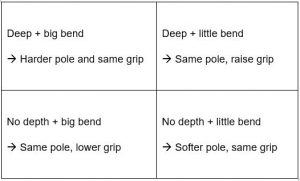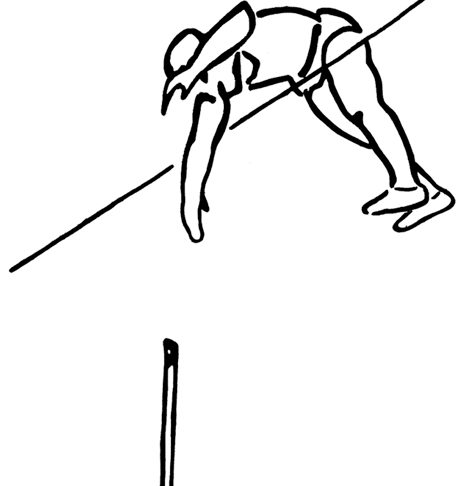There’s a (first) basic rule of thumb consisting of 2 parameters:
– Where does the athlete land? Close to the box or deep in the pit?
– How much was the pole bent? Lots of bending or not so much?
The answers to these questions give a simple matrix:

A big bending is in most cases not a good sign because the more bending the less control. To control a big bending lots of experience is needed. Before you get that experience you either risk your health or the nerves of you coach. Additionally: Bending poles to their limits causes them more likely to burst than not doing so.
Rule of thumb No. 2: A little bit less bending is better than a bit too much bending. This goes conform with the approach that you should start jumping on straight poles and then step by step learn to jump on bending poles.
Bending the pole shortens the distance between your top hand, your centre of gravity and the box, that can be used to jump higher, but if you want to follow that (Lavillenie-) approach first you have to get experienced. The more bending the later the moment you get feedback if you are still moving towards the bar or if you are likely being shot straight up (and will fall straight down).
Lots of bending is not needed to jump high in any technical approach. Kendricks and Morgunov jumped 6.00m+ gripping lower than 4.90m. They did not gain height from heavy bending.
An important indicator of good relation between grip-height and pole stiffness is the difference between your top hand and the bar you can clear. For women this should be 40cm and more, for men 70cm and more. The best have twice as much, 80cm and 140cm respectively. If you calculate your difference don’t forget the 20cm depth of the box. Gripping 4.40m and jumping 5.00m means 80cm of difference.
Grip height and stiffness of the pole should be in balance. If your grip is higher than the listed women below but you have a difference of only 20cm you should think about your technique and about getting on bigger poles while maybe lowering your grip.
Timur Morgunov: Grip height 4.85m, Result 6.00m, Difference top hand to bar: 1.35m
Sam Kendricks: Grip height 4.90m, Result 6.06m, Difference 1.36m
Renaud Lavillenie: Grip height 5.10m, Result 6.16m, Difference: 1.26m
Paul Burgess: Grip height 4.95m, Result 6.01m, Difference 1.26m
Nicole Büchler: Grip height 4.26m, Result 4.80m, Difference 0.74m
Angelica Bengtsson: Grip height 4.30m, Result 4.81m, Difference 0.71m
Angelica Sidorova: Grip height 4.41m, Result 4.95m, Difference 0.74m
You see a lot of beginner and advanced athletes over-gripping, meaning that their main goal is to increase their grip height to jump higher. That is at first look logical, but in the long run it isn’t the way to success.
For example, someone has a grip height of 4.20m and jumps 4.30m, then he raises his grip over years to finally grip at 4.80m and jump 5.00m. Well, with that grip others jump 5.80m. So that athlete never learned using his body to move bigger poles.
Also this ration between grip-height and difference (between your top hand and the bar you can clear) is a good indicator, wheatear you should change your pole or your grip to be in balance. Rule of thumb No. 3:
Grip-height 4.00m, Result 4.20+ 3.70m is poor, 4.30+ is really good
Grip-height 4.30m, Result 4.60+ 4.10m is poor, 4.70+ is really good
Grip-height 4.60m, Result 5.00+ 4.60m is poor, 5.30+ is really good
Grip-height 4.80m, Result 5.30+ 5.00m is poor, 5.70+ is really good
Using these simple 3 rules of thumb you have a good guideline.
Everything else is experience. First the coaches experience and then more and more the athletes experience. As coach you have to get an eye, a feeling for the balance between grip height and stiffness of the pole for different athletes. Athletes can be tall, short, slow, fast, thin and bulky. For all these types there is a balance between grip height and stiffness on every run-up from 4 steps to 20 steps and on every pole they are using.
There is no math behind perfect grip height to stiffness ratio, only experience.
If an athlete raises his grip also his technique will change a bit; the same happens using a harder (or softer) pole.
These interrelated challenges are one of the reasons why experienced pole vault coaches prefer to look after only one or two athlete at a time, not for 5, 8 or 10 athletes at a time. You have that picture of your athlete jumping in your mind and you like your brain to tell you what is right and what is wrong. If you have to look after 5 athletes, your brain has to switch back to the model it has for athlete 1 after it has watched athletes 2 to 5. That’s not possible with the same quality.
Good news is, learning by experience is easy, if you are willing to collect lots of experience over years. Learning by watching functions the same way as every learning-process. The brain starts to build chunks (see Prof. Ericsson, Peak). As a professional chess player knows what there is to do, when he steps up to a certain chess board situation an experienced pole vault coach immediately understands situations by simply watching the athletes and let the brain match the sample with its data record. The more data his system has the better the result.
If you want success, get an experienced coach (see Prof. Ericsson, Peak).
